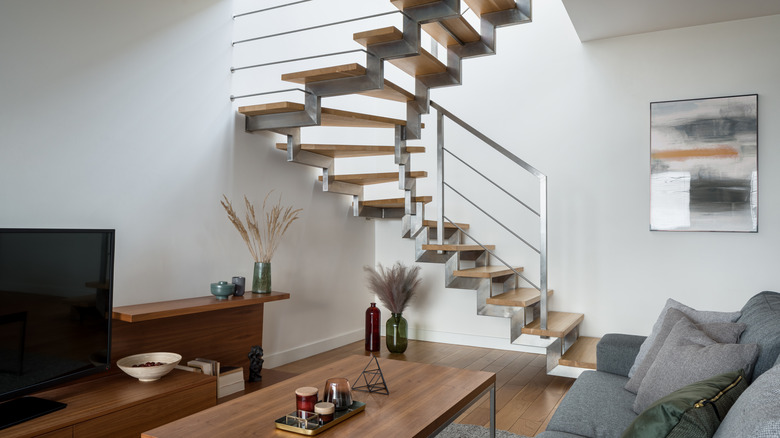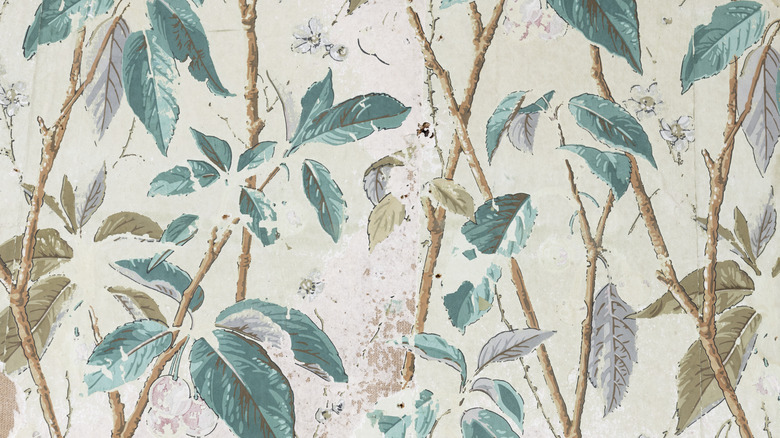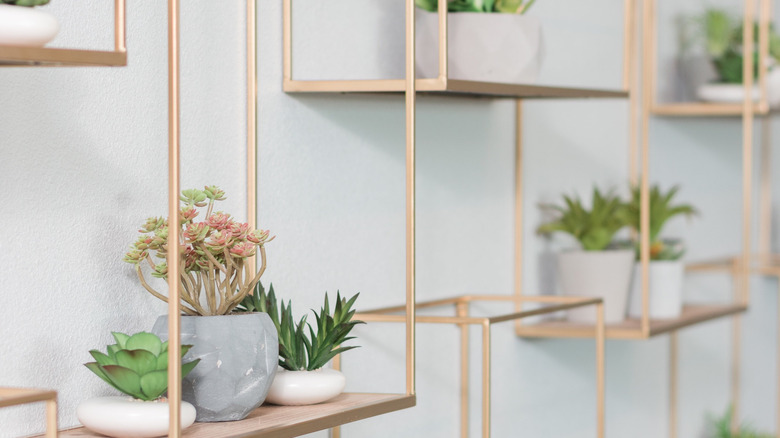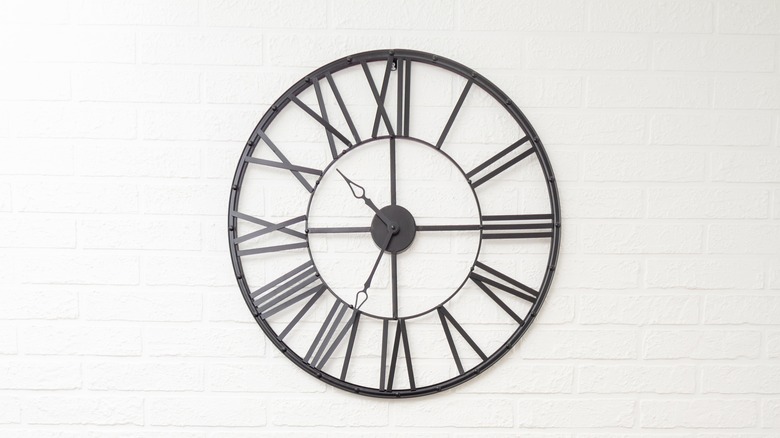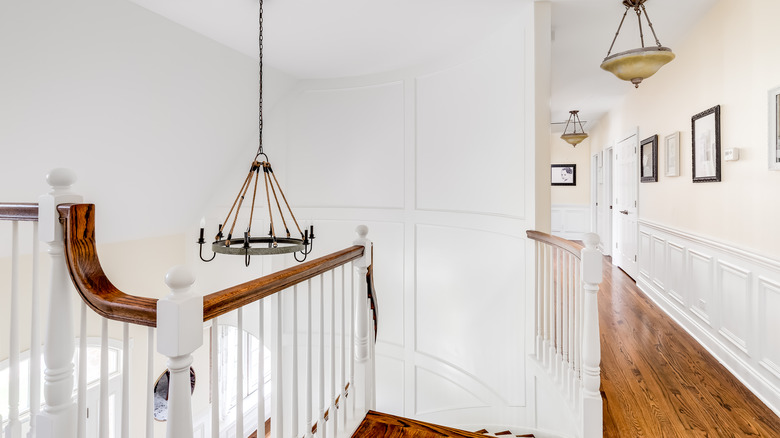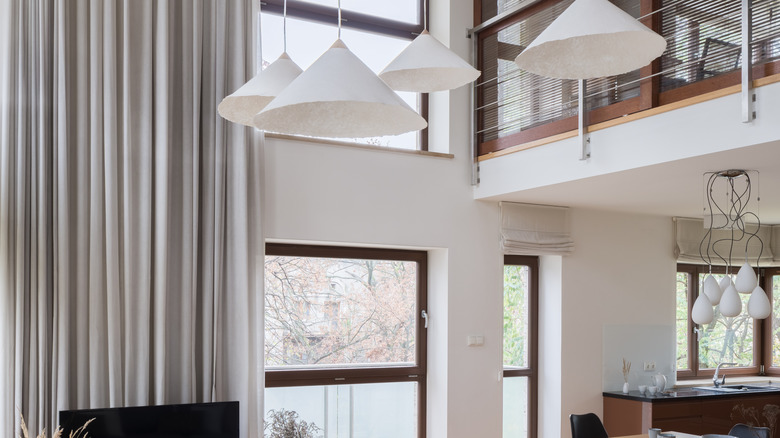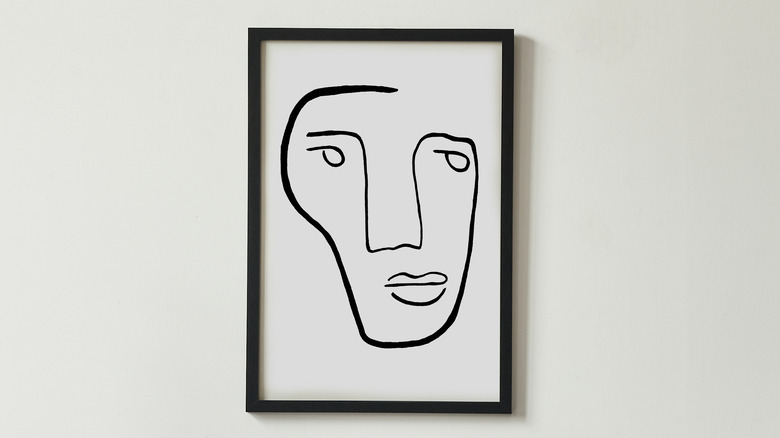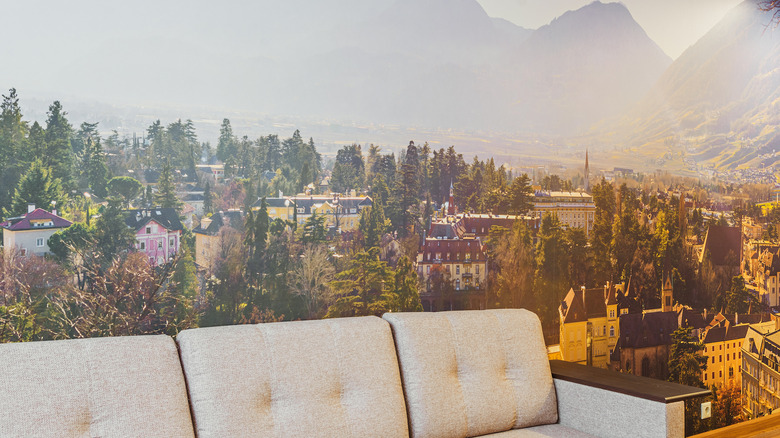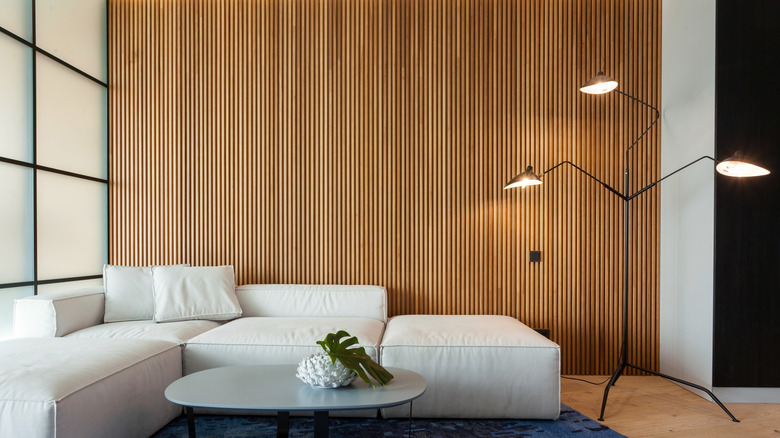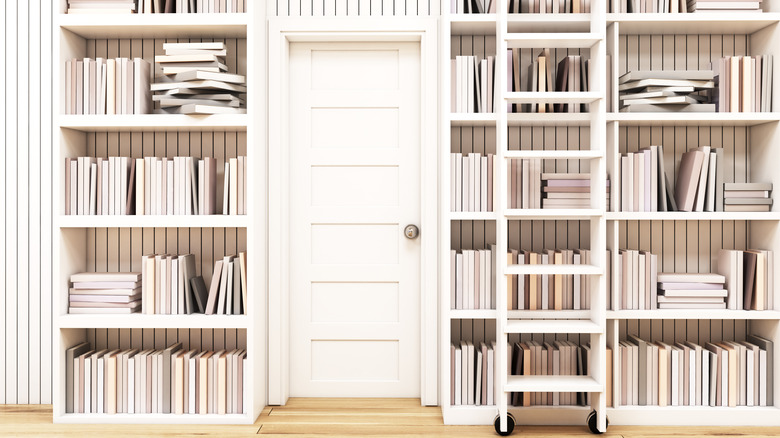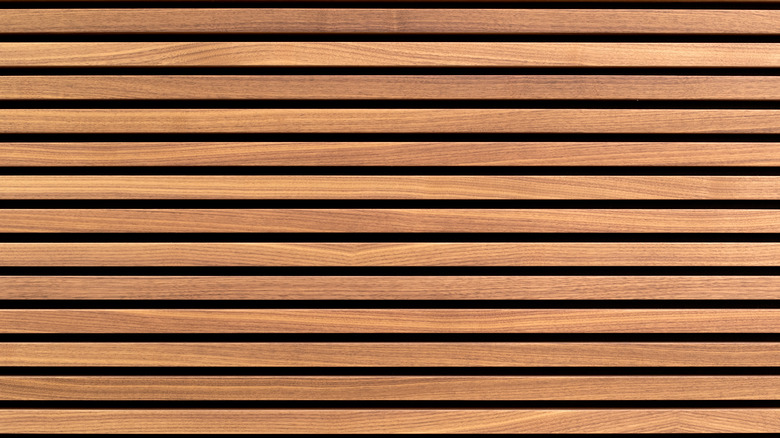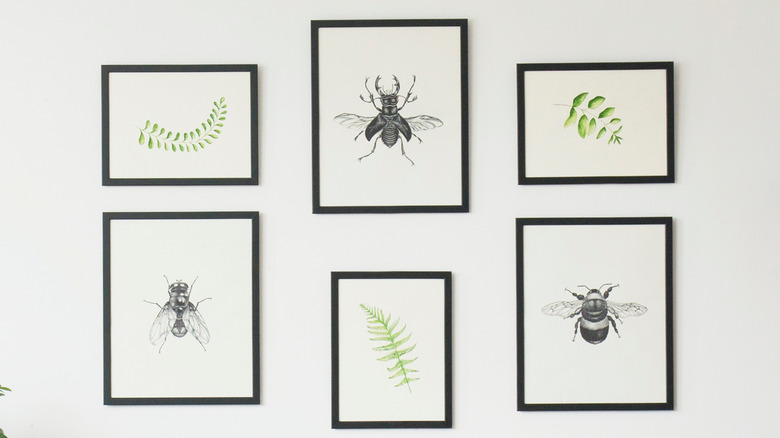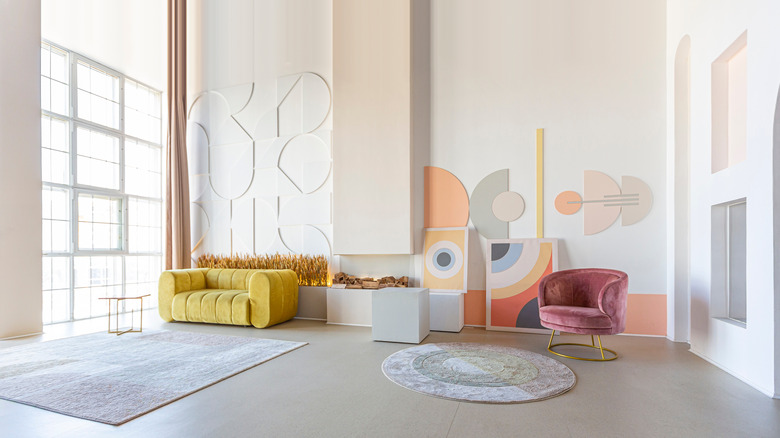How To Decorate A Two-Story Wall
To paraphrase the inimitable Chandler Bing from "Friends," could a two-story wall be more grand and impressive? Having a two-story wall in your home pretty much screams opulence, and presents a world of possibility. With that much space, you can pretty much do whatever you want, and whether your deal is shelves or signage, being presented with a two-story wall allows you to truly go to town. Or, if you prefer the minimalist aesthetic, you can decorate the open space with one or two highly-curated items.
Yet, the sheer size of some two-story walls presents not just opportunity, but difficulty too. The height of large two-story walls means that not only can ideas be difficult to generate, but things can go from minimalist to looking seriously bare pretty fast, as interior designer Corey Damen Jenkins points out for MasterClass. When done right, however, a large wall can add drama and presence that your guests will love, and here at House Digest, we're going to help you nail it. Let's take a look at how to decorate a two-story wall.
Use wallpaper to embrace the height
Opinions can vary widely on the use of wallpaper, but when done right, using wall coverings can be just as effective as paint when framing a room. And anyway, that paisley pattern you've always wanted for your walls is very hard to recreate with paint, trust us. Using wallpaper on a two-story wall is a particularly intelligent choice, as when done correctly, it can serve to either draw focus to the height or reduce the imposing feeling a taller wall can bring, as Wallpaper from the 70s states. If you're looking to minimize the feeling of height, opting for darker wallpapers can help a room feel more intimate, and brighter colors with more lively patterns will take the sting out of that towering sensation, delivering a visual party instead.
To make the space feel less cavernous, leave a gap between the wallpaper and ceiling, visually shortening the room. On the other hand, if you want to celebrate your two-story wall, lighter tones will help create a feeling of airiness and space. Just bear in mind that wallpapering a two-story wall is a potentially hazardous job, and depending on the height of your space, may need scaffolding. Make sure you use a professional contractor to avoid any accidents.
Go big with shelving
Ever struggled with storage in a home? Well, if you're the proud owner of a two-story wall, your worries are over, friend. Creating some seriously tall floor-to-ceiling shelving is the ideal way to make a statement while simultaneously providing a practical place to store your items. One useful way to keep your shelves visually interesting in a larger space is to mix the media stored on them, says The Spruce. Try pairing books with artwork, for example, placed in different layers and arrangements. After all, you'll have room for it!
Just make sure that, when you're using your shelf space, you're making choices that are in line with your room's aesthetic. "When arranging items on the floor-to-ceiling shelves, make sure to match them to the color scheme of your living room," advises Everwallpaper's CEO Lily Wili. "If the space is designed with neutral tones, then simple ceramic decorations and potted plants would look great." Wili makes a good point here: The last thing you want is to have to find a way to get that bright-red ornament down when it's two stories up!
Create a moment with a bold decoration
There comes a time in everyone's life when they have to decide whether to hide from something or go all out. For you, that might be when you come face-to-face with your two-story wall, thinking about how to make it as unnoticeable as possible. Well, you could go the other way, and seize the moment with your two-story wall, using a bold decoration to make it firmly the centerpiece of your space.
While your personal choice of eye-catching decoration has an extensive range, from neon signs to massive artwork, an oversized clock on a two-story expanse might be just what you're looking for. A super-large, oversized clock can take center stage on a large wall, as The Fancy Place discusses, with older-style clocks complementing a more classic design aesthetic, and modern metal clocks bringing things firmly into the contemporary space. Just remember that, if you're hanging your metal clock high up, you need to keep safety in mind when doing so. Make sure that the place you're hanging the clock on has a stud behind it before securing it. The last thing you want is for it to come crashing down with no notice.
Hanging lighting fixtures can help accentuate two-story walls
Two-story walls, particularly in living spaces or entry halls, bring a natural sense of grandness and elegance. So why fight that feeling? Lean into it and embrace the grandeur a two-story wall provides with a hanging light fixture. You can give your home the Versailles treatment with an ornate antique chandelier, or go for something more modern and focused with low-hanging pendant lighting.
If you're working with a two-story foyer, you may want to use your second story as a rough height point to which you can hang your lighting, advises SFGate. That way, the height of your lighting won't feel directionless, and you'll have a visual point of focus both from the upstairs story and from downstairs. If your two-story space has windows along the upper edges, it may also work to align your lights with those, to give an interesting perspective from outside your home.
Use two-story curtains to give a sense of softness
While two-story walls offer lots of design possibilities, some of them end up looking austere. So, if you're feeling the need to introduce a little more softness into your space, using long curtains against your wall can help to lessen the impact of a two-story wall and help your room feel welcoming and cozy.
The best part is, you don't even need to have towering windows to make use of two-story curtains. As a purely decorative addition, two-story curtains can be used on windowless walls to help frame a space, particularly useful if your two-story wall is wide and has furniture placed against it. If you do have tall windows, however, two-story curtains are the ideal way to usher in the light during the day and keep it out at night, should you desire them to be functional, according to Sengerson. Opting for neutral colors for your two-story curtains will help to keep them incorporated into the design but not too overbearing. Bear in mind, too, that closing two-story curtains is hard, so you may wish to keep them as features that aren't used, to save yourself the hassle of trying to draw them nightly.
Large wall art can bring a two-story wall to life
Every home should have a little art in it, and your two-story wall may be the perfect place to exhibit your favorite pieces. In fact, a two-story wall is a perfect opportunity to make a statement with just one super-large piece of art, creating a gallery-like moment in your home. Using an art print with bold color and a strong pattern, particularly in neutral spaces, can create a real "wow" effect on a larger wall, as MyDomaine shows.
Alternatively, break up the sheer size of the space and use it to display a cluster or collection of smaller pieces, giving the eye different levels and visuals to work with. While most people think of art as something contained in a frame, virtually anything can be considered art (an idea which modern artists have truly run with). Try and source a large antique mirror frame, or a left-field accent piece, to place on your wall. Lastly, your art doesn't have to be the main thing in your space: More subtle prints that complement the color palette in your home can be a great way to fill up a two-story wall.
Consider a large-scale installation
A wall installation on a two-story wall can be an incredible way to create a subtle, yet eye-catching effect on your larger space, giving the wall something to do in your room while also not drawing too much focus. For example, creating or purchasing an elegant butterfly wall installation helps draw the eye diagonally across the wall, making it feel more ingrained in the space. Such an installation adds more color and texture to the room without overpowering the furniture or the space itself, as Forbes shows.
If you want to get a little braver, using textiles as part of a wall installation can soften a space in surprising ways. This mimics how castles and old-world mansions used tapestries to soften their huge rooms. It's also a great way to incorporate texture and a pop of bold color, especially if the rest of the room is neutral.
A mural on a two-story wall can be a showstopper
Murals might be a slightly intimidating prospect for your home, but when you're faced with filling a two-story wall, they can turn from frightening to essential. "Using a mural is a wonderful decorative way to personalize a space," states Casart Coverings' Lorre Lei to Houzz. "Being able to customize the mural enables you to have something that is completely unique and one-of-a-kind."
And while people commonly associate murals with outdoor or public spaces, it's entirely possible, with a two-story wall, to create something that speaks to the aesthetic of your home. Remember, too, that murals don't have to be just painted. They can be incorporated as part of a wallpaper, or can even be installed as a separate piece, helping with their portability and potential to be reused. "If you use a product that's also removable and reusable, there's the added advantage that, if you should move, you can take your mural with you and re-install in your new space," advises Lei.
Two-tone paint can take the sting out of two-story walls
Block colors on walls can give a room a sense of uniformity, but when it comes to larger and taller walls, that uniformity can begin to feel slightly oppressive. Two-story walls have a habit of feeling (ready for the understatement of the century?) very, very tall, and clever paint techniques can help to diminish this feeling. Using a two-toned paint technique is a canny way to achieve this, contrasting the walls and the ceilings in similar shades to bring the feeling of height down, states Impressive Interior Design.
To do this, simply select two shades of the same color. Earth tones like browns or deep yellows can help to make a wall feel shorter and bring warmth into your space. Use the darker shade of the color chosen on your walls, and then on your ceiling, paint the lighter shade. The contrast will help bring your walls in a touch while maintaining a sense of openness up above. Just make sure to be very careful when painting the ceiling of a two-story wall, as it can be incredibly hazardous and should only be attempted with properly-erected scaffolding and with the correct safety equipment. We recommend outsourcing the job to a professional contractor.
Paneling a two-story wall can give it a stately feel
We're just gonna say it, folks. We don't see enough paneling these days. It's easy to write off paneling as old-fashioned, but we think it can give your home more than a little charm and coziness and can create a particularly appealing farmhouse feel for two-story walls, which can tend towards the clinical. If you really want to go old-school, Jacobean-style grid paneling can deliver a huge visual moment on a two-story wall, while keeping things from getting too towering when painted in darker tones, as seen via Ideal Home. Grid-style paneling is also great as it can give a natural framing effect for any artwork you might want to hang up.
Rectangular paneling can also cleverly accentuate the height of a space, but keep in mind that if you use narrow vertical wood paneling on a two-story wall, people are going to notice the height of your space. Narrow vertical paneling will naturally draw the eye up. Horizontal paneling on a two-story wall, on the other hand, can help things feel a little less lofty, as can paneling that only covers the lower sections of a wall.
A library ladder can accentuate the height
At the end of the day, there's no escaping the fact that two-story walls are pretty tall. And sometimes, it's better to just accept this fact, and then go with it. That's why, if you're looking for something interesting to do with your two-story wall, a library ladder could be a unique and exciting feature that keeps the height of your space on show but does something with it. A library ladder can exist on its own against a two-story wall, but we prefer combining it with tall shelving holding your books to give the ladder a sense of purpose. This works great for open-concept homes, as seen via Bob Vila.
Bear in mind, though, that adding a library ladder isn't as simple as just sticking a ladder against a wall (well, it could be, but that'd be pretty unsafe). Library ladders mounted against a rail with wheels attached to the bottom give an old-school feel and allow you to access books or objects right across your wall, according to Houzz. While library ladders can be constructed and mounted by budding DIYers, be warned that this is a job that could take a fair bit of technical know-how, and installing anything at a high level can be dangerous.
Stripes can bring the height of a wall down
Two-story walls can, sometimes, be overwhelming. There's no denying it. And if you're finding yourself faced with this feeling, never fear, as there are ways that you can capably reduce the feeling of too-much height in a space. Horizontal stripes can help keep the eye from traveling up too far on a two-story wall, and aside from that, they're a classic, elegant look.
When you're decorating with stripes, though, it pays to follow a few key design principles. First off, remember that a little goes a long way, and you don't want them to be your only feature. "Stripes always make a big impact, particularly when used on walls, so visually they really need to be broken up with art or else they can overpower a space," advises Annsley Interiors principal designer Annsley McAleer to Architectural Digest. The same sense of judiciousness when using stripes shouldn't just be applied to your walls, either. "I love striped walls, a striped ceiling, striped window treatments, or a striped area rug, but I would never use any of them together," says product and interior designer Jeff Andrews to Architectural Digest. "You don't want to feel like you're in jail."
Use the height for a gallery wall
Thinking logically here, a two-story wall is a perfect display area. After all, you've got the space for it, right? And so, if you're thinking about putting that area to good use and want to enliven your space, a gallery wall could be an awesome use.
Keep in mind that it's useful to do something a little more specific for a two-story wall than just putting up a few pictures to keep the space dynamic. "For larger gallery walls, using a variety of sizes will draw the eye across the arrangement," recommends Heal's stylist Anna Sheridan to Ideal Home. "If this is the look you want to create, try to avoid pairing identical sizes together, such as two portrait A3 pieces, as this will make the overall design feel disjointed. Keep the larger frames central and use around 25 percent of the total display to work in brighter colors." The larger frames will also work as a point of focus, giving your gallery wall order and purpose. For a two-story wall, planning the layout of your gallery is key to make sure you're making the space feel full while not overwhelming your room with too much on display.
Divide up the space
In some open-concept homes, two-story walls can start to feel a little bit too big. Short of projecting an IMAX cinema screen onto them, what do you do when your two-story wall is part of an open space, and all you can do is gaze ever-upward?
In these situations, division is key. Dividing up your two-story wall visually can take some of the heat out of its size, either vertically or horizontally. Vertical divisions can be really effective to bring the eye down and can be achieved through a variety of methods, from splitting the room visually with contrasting paint shades, to adding paneling to the lower half of the wall, as Tidbits and Twine shows. Using a dynamic contrast of light and dark between the lower and upper sections of the wall can stop a division from feeling too vague. Horizontally, separating a space with one hanging feature, placed in the rough center of a wide two-story wall, can help organize space and give your room two points of focus. This can be particularly useful in open-concept homes to demarcate different living areas.
